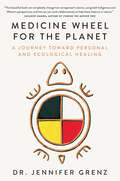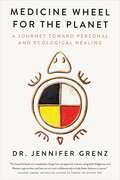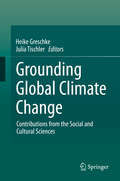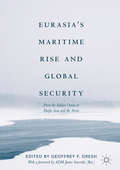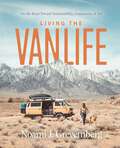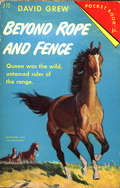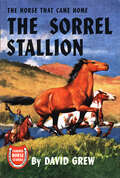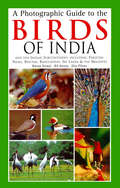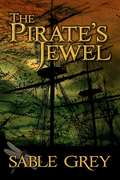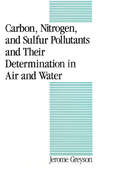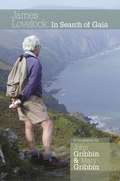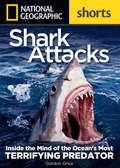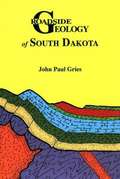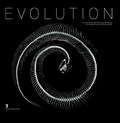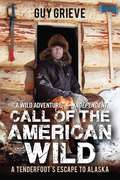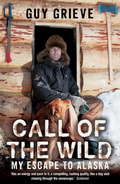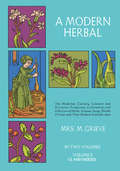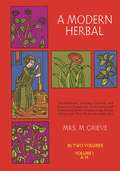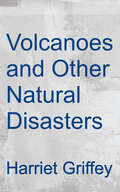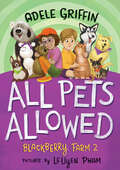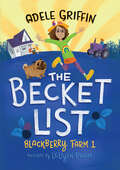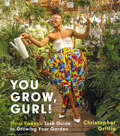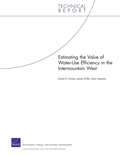- Table View
- List View
Medicine Wheel for the Planet: A Journey toward Personal and Ecological Healing
by Dr. Jennifer Grenz"This beautiful book can completely change how we approach science, using both Indigenous and Western perspectives, and how we can work collaboratively to help foster balance in nature." —Suzanne Simard, bestselling author of Finding the Mother TreeA farm kid at heart, and a Nlaka'pamux woman of mixed ancestry, Dr. Jennifer Grenz always felt a deep connection to the land. However, after nearly two decades of working as a restoration ecologist in the Pacific Northwest, she became frustrated that despite the best efforts of her colleagues and numerous volunteers, they weren't making the meaningful change needed for plant, animal and human communities to adapt to a warming climate. Restoration ecology is grounded in an idea that we must return the natural world to an untouched, pristine state, placing humans in a godlike role—a notion at odds with Indigenous histories of purposeful, reciprocal interaction with the environment. This disconnect sent Dr. Grenz on a personal journey of joining her head (Western science) and her heart (Indigenous worldview) to find a truer path toward ecological healing.In Medicine Wheel for the Planet, building on sacred stories, field observations and her own journey, Dr. Grenz invites readers to share in the teachings of the four directions of the medicine wheel: the North, which draws upon the knowledge and wisdom of elders; the East, where we let go of colonial narratives and see with fresh eyes; the South, where we apply new-old worldviews to envision a way forward; and the West, where a relational approach to land reconciliation is realized. Eloquent, inspiring and disruptive, Medicine Wheel for the Planet circles toward an argument that we need more than a singular worldview to protect the planet and make the significant changes we are running out of time for.
Medicine Wheel for the Planet: A Journey Toward Personal and Ecological Healing
by Jennifer GrenzA personal journey of bringing together Western science and Indigenous ecology to transform our understanding of the human role in healing our planetI used to be an ecologist. . . . Now, I am a community gatherer, working to help bring healing beyond just the land. I am a story-listener. I am a storyteller. I am a shaper of ecosystems. I work on bringing communities together, in circle, to listen to each other. A farm kid at heart, and a Nlaka&’pamux woman of mixed ancestry, Dr. Jennifer Grenz always felt a deep connection to the land. However, after nearly two decades of working as a restoration ecologist in the Pacific Northwest, she became frustrated that despite the best efforts of her colleagues and numerous volunteers, they weren&’t making the meaningful change needed for plant, animal, and human communities to adapt to a warming climate. Restoration ecology is grounded in an idea that we must return the natural world to an untouched, pristine state, placing humans in a godlike role—a notion at odds with Indigenous histories of purposeful, reciprocal interaction with the environment. This disconnect sent Dr. Grenz on a personal journey of joining her head (Western science) and her heart (Indigenous worldview) to find a truer path toward ecological healing. In Medicine Wheel for the Planet, building on sacred stories, field observations, and her own journey, Dr. Grenz invites readers to share in the teachings of the four directions of the medicine wheel: the North, which draws upon the knowledge and wisdom of elders; the East, where we let go of colonial narratives and see with fresh eyes; the South, where we apply new-old worldviews to envision a way forward; and the West, where a relational approach to land reconciliation is realized. Eloquent, inspiring, and disruptive, Medicine Wheel for the Planet circles around an argument that we need more than a singular worldview to protect the planet and make the significant changes we are running out of time for.
Grounding Global Climate Change
by Heike Greschke Julia TischlerThis book traces the evolution of climate change research, which, long dominated by the natural sciences, now sees greater involvement with disciplines studying the socio-cultural implications of change. In their introduction, the editors chart the changing role of the social and cultural sciences, delineating three strands of research: socio-critical approaches which connect climate change to a call for cultural or systemic change; a mitigation and adaption strand which takes the physical reality of climate change as a starting point, and focuses on the concerns of climate change-affected communities and their participation in political action; and finally, culture-sensitive research which places emphasis on indigenous peoples, who contribute the least to the causes of climate change, who are affected most by its consequences, and who have the least leverage to influence a solution. Part I of the book explores interdisciplinarity, climate research and the role of the social sciences, including the concept of ecological novelty, an assessment of progress since the first Rio climate conference, and a 'global village' case study from Portugal. Part II surveys ethnographic perspectives in the search for social facts of global climate change, including climate and mobility in the West African Sahel, and human-non human interactions and climate change in the Canadian Subarctic. Part III shows how collaborative and comparative ethnographies can spin "global webs of local knowledge," describing case studies of changing seasonality in Labrador and of rising water levels in the Chesapeake Bay. These perspectives are subjected to often-amusing, always incisive analysis in a concluding chapter entitled "You Ain't Seen Nothing Yet: a death-defying look at the future of the climate debate. " The contributors engage critically with the research subject of 'climate change' itself, reflecting on their own practices of knowledge production and epistemological presuppositions. Finely detailed and sympathetic to a broad range of viewpoints, the book sets out a profile for the social sciences and humanities in the climate change field by systematically exploring methodological and theoretical challenges and approaches.
Eurasia’s Maritime Rise and Global Security: From The Indian Ocean To Pacific Asia And The Arctic (Palgrave Studies in Maritime Politics and Security)
by Geoffrey F. GreshThis book explores Eurasia’s growing embrace of its maritime geography from the Indian Ocean to Pacific Asia and the Arctic. In an age of climate change, the melting of the Arctic will transform Eurasia’s importance, in addition to influencing the political, economic, and military dynamics across Eurasia’s main maritime regions. These emerging shifts have already begun to alter maritime trade and investment patterns, and thus the global political economy. It also creates a rising threat to the current status quo of world order that has long been dominated by the Atlantic World. This edited volume showcases some of the world’s leading experts and examines Eurasia from a saltwater perspective, analyzing its main maritime spaces in a threefold manner—as avenue, as arena, as source—to show the significance of this geostrategic change and why it matters for the future of the world’s oceans.
Living the Vanlife: On the Road Toward Sustainability, Community, and Joy
by Noami GrevembergDiscover what it&’s really like to live and work full-time on the road in a camper van from eco-vanlifer and founder of the Diversify Vanlife movement, Noami Grevemberg.Feeling dissatisfied with her office job and her &“stationary home,&” in 2016 Noami Grevemberg took a bold step. She quit her job, sold her belongings, and set out in her 1985 VW Vanagon to pursue a life of simplicity and travel with her husband and German Shepherd by her side. In her years living fulltime on the road, Noami has become an expert in the many aspects of vanlife. In her book Living the Vanlife, she digs into all aspects of the lifestyle, from getting over the uncomfortable feeling of uncertainty, to creating a sustainable, thriving life of adventure and a captivating path of choosing whatever it is you truly want for yourself. Through personal stories and actionable advice, Noami candidly and compassionately demonstrates for readers that challenging the "status quo&” means taking bold steps, venturing out of your comfort zone, taking risks, and living intentionally. As a Trinidadian immigrant, Noami also takes a practical look at life on the road as a BIPOC navigating many intersections and speaks to topics like converting a van to fit your specific needs, budgeting for vanlife, finding employment, staying safe, and building a supportive community on the road. Featuring evocative full-color photographs of Noami&’s journey, Living the Vanlife is an inclusive and celebratory look at an increasingly popular way of life.
Beyond Rope and Fence (Famous Horse Stories)
by David GrewA black-maned buckskin like her mother, Queen was born on the open prairie, and early learned to fear the very sight and smell of men. As she grew to maturity, Queen became a wise and crafty leader of the wild band, leading it north whenever she saw men on the horizon. Caught at last, and apparently tamed, Queen waited only the chance to rejoin her mate and the herd on the free, open ranges she loved.
The Sorrel Stallion: The Horse That Came Home (Famous Horse Stories)
by David GrewHere is the story of an American "Black Beauty." Instead of the English countryside and London streets, we have the Idaho range country and timberlands for the background of this western stallion's adventures. Sorrel, named for his color, is born in the spring on the great range that borders the Clearwater. His first contact with man is pleasant enough, but all too soon he is captured, to escape with Pinto, his mate, to roam the range wild and free as the wind that sweeps down from the snow-capped mountains. But the day comes when Sorrel is recaptured and his gallant spirit almost broken to the saddle and the plow. Stolen by prospectors who sell him to the Forest Rangers, Sorrel endures long years of exciting adventure and grueling toil with the Rangers. During a terrible forest fire, Sorrel, now old and broken, makes his way south through the Clearwater Canyon, and back to the ranch he fled from but never forgot, there to live in comfort for the rest of his days.
A Photographic Guide to the Birds of India
by Bikram GrewalPeriplus is proud to present the first comprehensive photographic guide to the birds of the Indian subcontinent. This ebook offers over 800 species and distinct sub-species and contains over 1,000 full-color photographs. Each species has a distribution map. Many of the photographs in this magnificent volume appear for the first time and have been carefully selected to show the most important features of the species illustrated. In several cases, different plumages or flight shots are included. The concise text provided vital information on the plumages, voice and habits of each species covered and includes new information. Over a hundred related species are also mentioned in the texts. The maps are accompanied by a note on the status and distribution. This ebook will enable accurate field identification in one of the world's most diverse avifaunal regions. Indispensable reading for all bird lovers.
A Photographic Guide to the Birds of India
by Bikram GrewalPeriplus is proud to present the first comprehensive photographic guide to the birds of the Indian subcontinent. This ebook offers over 800 species and distinct sub-species and contains over 1,000 full-color photographs. Each species has a distribution map. Many of the photographs in this magnificent volume appear for the first time and have been carefully selected to show the most important features of the species illustrated. In several cases, different plumages or flight shots are included. The concise text provided vital information on the plumages, voice and habits of each species covered and includes new information. Over a hundred related species are also mentioned in the texts. The maps are accompanied by a note on the status and distribution. This ebook will enable accurate field identification in one of the world's most diverse avifaunal regions. Indispensable reading for all bird lovers.
A Photographic Guide to the BIRDS OF INDIA
by Bikram Grewal Bill Harvey Otto PfisterThis guide covers 800 species found in India. Each species description is illustrated with a photograph and distribution map, making this a quick-reference guide in a pocketable format. Introductory sections include general information, such as the biogeography of the region covered.
The Pirate's Jewel
by Sable GreyDuring a time when swashbucklers, privateers, and the Royal Navy battled across the waters, one buccaneer stood out from the rest: raven-haired, green-eyed, and nicknamed the Pirate's Jewel. However, this fiery sea rover answers to no one except herself.Captain Merrick Cole has never met a woman as tough and fearless as Rafferty Jones, nor has he ever had one as sexually matched. Clever, cunning, and dangerously sexy, she's just the kind of woman that can stir a man's blood.Following the orders he is commissioned, Cole captures the woman pirate and sets sail back to London where his commander, John Thornton, wants her delivered and hung. But Rafferty Jones proves she will not go easily, nor will she stifle basic human urges along the way. Cole is prepared to entertain her sexual appetites, but can he remain in control when lust turns to love?
Carbon, Nitrogen, and Sulfur Pollutants and Their Determination in Air and Water
by Jerome C. GreysonFor chemists and engineers in ecology, food science, pollution control, and related fields. Details the procedures available for monitoring and controlling carbon, sulfur, and nitrogen pollutants in such industries as waste water treatment, energy, transportation, pharmaceuticals, and mining. Outlin
James Lovelock: In Search of Gaia
by John Gribbin Mary GribbinIn 1972, when James Lovelock first proposed the Gaia hypothesis--the idea that the Earth is a living organism that maintains conditions suitable for life--he was ridiculed by the scientific establishment. Today Lovelock's revolutionary insight, though still extremely controversial, is recognized as one of the most creative, provocative, and captivating scientific ideas of our time. James Lovelock tells for the first time the whole story of this maverick scientist's life and how it served as a unique preparation for the idea of Gaia. Drawing on in-depth interviews with Lovelock himself and unprecedented access to his private papers, John and Mary Gribbin paint an intimate and fascinating portrait of a restless, uniquely gifted freethinker. In a lifetime spanning almost a century, Lovelock has followed a career path that led him from chemistry, to medicine, to engineering, to space science. He worked for the British secret service and contributed to the success of the D-Day landings in World War II. He was a medical experimenter and an accomplished inventor. And he was working with NASA on methods for finding possible life on Mars when he struck upon the idea of Gaia, conceiving of the Earth as a vast, living, self-regulating system. Deftly framed within the context of today's mounting global-warming crisis, James Lovelock traces the intertwining trajectories of Lovelock's life and the famous idea it brought forth, which continues to provoke passionate debate about the nature and future of life on our planet.
Shark Attacks: Inside the Mind of the Ocean's Most Terrifying Predator
by Gordon GriceSharks are the world's most fascinating predators - capable of detecting a single drop of blood in 25 million drops of ocean and sensing electricity emitted by their prey. This ebook short takes readers deep into the realm of the very latest shark science, including new insights into the nature of shark attacks around the world.
Roadside Geology of South Dakota
by John P. Gries James GriesemerA layperson's geological road map describing rocks and landforms along South Dakota's highways, as well as the geology lying beneath in caves and mine shafts. Gries (geology, South Dakota School of Mines) keeps it simple but informative, traveling from the glaciated prairies, across the Missouri River, and into the rugged Badlands Wall, the Needles, and the Homestake gold mine in the the West. Stops along the way include geologic tours of the Black Hills, Mount Rushmore, Wind Cave National Park, and Jewel Cave National Monument. Includes maps and photographs. Annotation c. by Book News, Inc., Portland, Or.
Evolution
by Patrick Gries Jean-Baptiste De Panafieu Linda AsherUnprecedented in its approach, the number and diversity of the species presented, and the quality of the photographs, Evolution is the book on how we came to be what we are. Spectacular, mysterious, elegant, or grotesque, the skeletons of the vertebrates that inhabit the earth today carry within them the imprint of an evolutionary process that has lasted several billion years. This book is the result of a dual approach, scientific as well as aesthetic, rigorous yet accessible. Each chapter is made up of a short text that illuminates one theme of the evolutionary process--repetition, adaptation, polymorphism, sexual selection, and more--and a series of exquisitely composed photographs of skeletons against a black background. Approximately three hundred photographs of whole skeletons or their details have been made possible by the French National Museum of Natural History. The reader learns, by experiencing each text and photograph together, how the structure of every creature has been shaped by its environmental and genetic inheritance.
Call of the American Wild: A Tenderfoot's Escape to Alaska
by Guy Grieve"A wild adventure. ” --Independent A man, an axe, and a dog named Fuzzy . . . let the adventure begin! Trapped in a job he hated and up to his neck in debt, Guy Grieve’s life was going nowhere. But with a stroke of luck, his dream of escaping it all to live in the remote Alaskan tundra suddenly came true. Miles from the nearest human being and armed with only the most basic equipment, Guy built a log cabin from scratch and began carving a life for himself through fishing, hunting, and diligently avoiding bears. Packed with adventure, humor, and insight, this is the gripping story of an ordinary man learning the ways of the wild.
Call of the Wild: My Escape to Alaska
by Guy GrieveGuy Grieve's life was going nowhere - trapped in a job he hated, commuting 2,000 miles a month and up to his neck in debt. But he dreamed of escaping it all to live alone in one of the wildest, most remote places on earth - Alaska. And just when he'd given up hope, the dream came true. Suddenly Guy was thrown into one of the harshest environments in the world, miles from the nearest human being and armed with only the most basic equipment. And he soon found - whether building a log cabin from scratch, hunting, ice fishing or of course dodging bears in the buff - that life in the wilderness was anything but easy...Part Ray Mears, part Bill Bryson, CALL OF THE WILD is the gripping story of how a mild-mannered commuter struggled with the elements - and himself - and eventually learned the ways of the wild.
A Modern Herbal: Vol. II
by Margaret GrieveIf you want to know how pleurisy root, lungwort, and abscess root got their names, how poison ivy used to treat rheumatism, or how garlic guarded against the Bubonic Plague, consult A Modern Herbal. This 20th-century version of the medieval Herbal is as rich in scientific fact and folklore as its predecessors and is equally encyclopedic in coverage. From aconite to zedoary, not an herb, grass, fungus, shrub or tree is overlooked; and strange and wonderful discoveries about even the most common of plants await the reader.Traditionally, an herbal combined the folk beliefs and tales about plants, the medicinal properties (and parts used) of the herbs, and their botanical classification. But Mrs. Grieve has extended and enlarged the tradition; her coverage of asafetida, bearberry, broom, chamomile, chickweed, dandelion, dock, elecampane, almond, eyebright, fenugreek, moss, fern, figwort, gentian, Hart's tongue, indigo, acacia, jaborandi, kava kava, lavender, pimpernel, rhubarb, squill, sage, thyme, sarsaparilla, unicorn root, valerian, woundwort, yew, etc. — more than 800 varieties in all — includes in addition methods of cultivation; the chemical constituents, dosages, and preparations of extracts and tinctures, unknown to earlier herbalists; possible economic and cosmetic properties, and detailed illustrations, from root to bud, of 161 plants.Of the many exceptional plants covered in Herbal, perhaps the most fascinating are the poisonous varieties — hemlock, poison oak, aconite, etc. — whose poisons, in certain cases, serve medical purposes and whose antidotes (if known) are given in detail. And of the many unique features, perhaps the most interesting are the hundreds of recipes and instructions for making ointments, lotions, sauces, wines, and fruit brandies like bilberry and carrot jam, elderberry and mint vinegar, sagina sauce, and cucumber lotion for sunburn; and the hundreds of prescriptions for tonics and liniments for bronchitis, arthritis, dropsy, jaundice, nervous tension, skin disease, and other ailments. 96 plates, 161 illustrations.
A Modern Herbal
by Margaret GrieveIf you want to know how pleurisy root, lungwort, and abscess root got their names, how poison ivy used to treat rheumatism, or how garlic guarded against the Bubonic Plague, consult A Modern Herbal. This 20th-century version of the medieval Herbal is as rich in scientific fact and folklore as its predecessors and is equally encyclopedic in coverage. From aconite to zedoary, not an herb, grass, fungus, shrub or tree is overlooked; and strange and wonderful discoveries about even the most common of plants await the reader.Traditionally, an herbal combined the folk beliefs and tales about plants, the medicinal properties (and parts used) of the herbs, and their botanical classification. But Mrs. Grieve has extended and enlarged the tradition; her coverage of asafetida, bearberry, broom, chamomile, chickweed, dandelion, dock, elecampane, almond, eyebright, fenugreek, moss, fern, figwort, gentian, Hart's tongue, indigo, acacia, jaborandi, kava kava, lavender, pimpernel, rhubarb, squill, sage, thyme, sarsaparilla, unicorn root, valerian, woundwort, yew, etc. — more than 800 varieties in all — includes in addition methods of cultivation; the chemical constituents, dosages, and preparations of extracts and tinctures, unknown to earlier herbalists; possible economic and cosmetic properties, and detailed illustrations, from root to bud, of 161 plants.Of the many exceptional plants covered in Herbal, perhaps the most fascinating are the poisonous varieties — hemlock, poison oak, aconite, etc. — whose poisons, in certain cases, serve medical purposes and whose antidotes (if known) are given in detail. And of the many unique features, perhaps the most interesting are the hundreds of recipes and instructions for making ointments, lotions, sauces, wines, and fruit brandies like bilberry and carrot jam, elderberry and mint vinegar, sagina sauce, and cucumber lotion for sunburn; and the hundreds of prescriptions for tonics and liniments for bronchitis, arthritis, dropsy, jaundice, nervous tension, skin disease, and other ailments. 96 plates, 161 illustrations.
Volcanoes and Other Natural Disasters (Dk Readers Series Dorling Kindersley Readers)
by Harriet Griffey Dorling Kindersley Publishing StaffDescribes natural disasters which have occurred in various places throughout the world including the eruption of Vesuvius in 79 A.D., the Yellow River flood in 1887, and the Australian bush fires in 1983.
All Pets Allowed: Blackberry Farm 2
by Adele GriffinNew dog, no tricks! Becket Branch has one birthday wish—a dog! Dogs are outgoing and friendly, and they live life loud, just like Becket. Becket&’s twin, Nicholas, wants a pet more like him—a peaceful, quiet indoor cat. When their parents take them to the shelter to choose a dog and a cat, it should be Becket&’s biggest BEAUTIFUL ALERT ever. But Becket&’s dream dog, Dibs, turns out to be a super-shy scaredy-pooch. Meanwhile, Nicholas&’s kitty, Given, loves being the center of attention and greeting visitors to Blackberry Farm. Can Becket and Nicholas learn how to love Dibs and Given as they are—even if they aren&’t exactly the pets the twins dreamed of? With black-and-white drawings throughout by award-winning illustrator LeUyen Pham (Real Friends), this second volume of the Blackberry Farm series offers a gentle message about embracing new friends who may not match preconceived expectations.
The Becket List: A Blackberry Farm Story
by Adele GriffinAdventure and discover with the bold and intrepid Becket Branch when her family’s move from city to a country farm means big changes! Everything is changing for Becket Branch. From subways to sidewalks to safety rules, Becket is a city kid born and raised. Now the Branch family is trading urban bustle for big green fields and moving to Gran’s farm, where Becket has to make sense of new routines from feeding animals to baling hay. And as much as Becket loves to yell “Beautiful Alert!” there’s a lot about the countryside that is just plain odd. But Becket is ready to put her own spin on country life. Whether selling her mouth-puckering lemonade, feeding hostile hens, or trying to make a best friend of her new neighbor Frieda Franca, Becket is determined to use her city smarts to get a grip on farm living. Laugh and learn with Becket as she mucks through the messy, exuberant human experience of change she didn’t ask for, in a story that sparkles with quirky characters and lasting connections.
You Grow, Gurl!: Plant Kween's Guide to Growing Your Garden
by Christopher GriffinDiscover the joys and self-nurturing benefits of plant parenthood, from learning how to begin building your own lush plant family to getting into those fun tips on how to care for your green gurls, with this beautiful, illustrated guide from the dazzling creator of the @plantkween Instagram account. “We all love some new growth, dahling.”Six years ago, Christopher Griffin was just beginning the plant parenthood journey with one small Marble Queen Pothos. Today, this Black Queer non-binary femme plant influencer known as Plant Kween tends to a family of more than 200 healthy green gurls in the Brooklyn apartment they call home. You Grow, Gurl! is Kween’s fun and fabulous guide to becoming a plant parent and keeping your green gurls growing and thriving.Anyone can be a plant parent! It’s all about TLC—taking the time and energy to focus on a plant’s needs, and ultimately your own. Featuring 200 full-color photos and illustrations, practical instructions and tips—on everything from propagating to measuring humidity to repotting—activities, and stories, this fun and joyful guide shows how to green-up any space and have it serving those lush lewks. Self-care takes many forms and tending to your plants’ needs helps you grow too. In addition to information and advice on plant care, Kween provides meditations, mindfulness activities, playlists, and more to help you practice self-care through plant-care. As Kween says, “We can learn a lot about how we treat ourselves, how we treat others, and how we navigate the world from these green lil creatures.” Healing and growing your heart, body, and soul takes time, love, and focus. Taking care of plants teaches you to apply that same attention and love to yourself and helps you find new pathways to explore on your own botanical adventure to self-love.
Estimating the Value of Water-Use Efficiency in the Intermountain West
by James Griffin David G. Groves Sara HajiamiriThis report presents an economic framework for estimating a water agency's avoided costs and environmental benefits of increasing water-use efficiency. The report demonstrates this framework by evaluating the benefits of Denver Water's efficiency programs and utilizes an exploratory modeling approach to accommodate significant uncertainty. The analysis highlights the importance of considering both long- and short-run costs and benefits.
